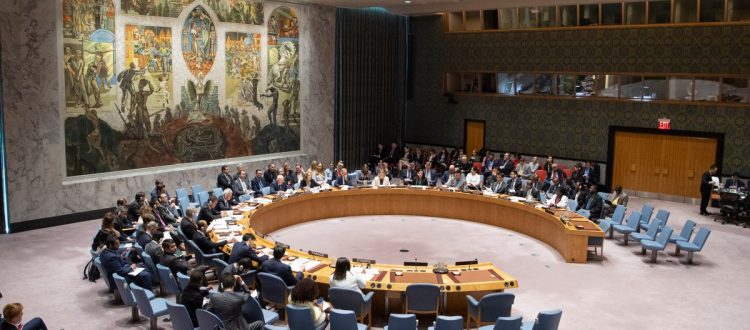Bringing youth to the table on issues of peace and security
With diversity comes improved creativity and innovation. In addition to countless other benefits of involving more diverse perspectives in peace and security conversations, the importance of allowing youth to take part in shaping the international legal architecture that will eventually govern us during times of conflict and instability is invaluable, and UNSCR 2419 is a positive step towards that goal. As a young person, I look forward to its implementation.
| Suggested Reading | Conflict Background | GCCT |
By Brenna Gautam
On June 6, 2018, the United Nations Security Council unanimously adopted Resolution 2419 (UNSCR 2419) on Increasing the Role of Youth in Negotiating and Implementing Peace Agreements. UNSCR 2419 stresses the importance of including the views of youth in discussions relating to peace and security, and calls for the full and equal participation of youth at decision-making levels. As a member of the Comprehensive Test Ban Treaty Organization Youth Group (CYG) and as a young woman interested in advancing peace and security, UNSCR 2419 speaks directly to me. Yet it leaves me wondering what legal effect this Resolution will carry in our world and how its provisions could translate into real change.
As a Security Council Resolution, UNSCR 2419 is likely non-binding, with a limited legal status. Its language “calls upon”, “recommends”, and “encourages” Member States and the Secretary General to act, but never “demands” or “requires” such action (this is referred to as exhortatory, rather than mandatory, language). But importantly, even if this Resolution is read at its least persuasive, it nevertheless serves as a building block in customary international law.
Customary international law consists of two prongs: state practice and opinio juris. If all states began including youth in peacebuilding initiatives, then slowly, over some number of years, this inclusivity could become state practice. Opinio juris is the requirement that states must not only act a certain way, but must believe their action stems from a legal obligation. States cannot simply adopt a practice of including the voices of youth; to create customary international law, states must believe that they are legally obligated to include those voices.
It is a strange legal fiction. Of course, a state has no physical mind and cannot truly believe anything. Scholars Omri Sender and Michael Wood have called opinio juris a theoretical controversy, a troubled concept.
But despite its strangeness, because it remains a requirement of customary international law, the question becomes: whose opinio juris? Whose belief matters in determining the belief of a state? According to Sender and Wood, a state’s belief may be demonstrated through public statements made on behalf of states, official publications, government legal opinions, diplomatic correspondence, decisions of national courts, treaty provisions, and conduct in connection with resolutions adopted by an international organization or at an intergovernmental conference.
If these are the manifestations of opinio juris, then the disappointing truth is that overwhelmingly, the beliefs of youth do not matter for the purposes of forming customary international law. Youth do not directly contribute to official publications, statements, or treaty provisions. Thus, we are again excluded from the construction of a system that we are then expected to adopt and inhabit—a system that impacts us at disparate rates compared to other generational categories. After all, more than 90 percent of all casualties of armed conflict occur among young men. Young women make up 10 to 30 percent of armed forced and armed groups worldwide.
And yet, I feel hopeful that the foundation may be shifting. Within the CYG, youth do contribute to some of these markers of state belief. The CYG is a diverse group of students and young graduates engaged in promoting the Comprehensive Test Ban Treaty, a United Nations treaty banning nuclear explosions, and its verification regime. We draft our own public statements in the wake of international developments, attend intergovernmental conferences, interact with and occupy many of the same spaces as public officials. Perhaps we engage in diplomacy on a more interpersonal level, with members from India and Pakistan collaborating on research projects, or students from Russia and the United States sitting down for a meal after a long day of conference presentations. Yet it is diplomacy nonetheless, and it is conducted against the backdrop of an international preparatory commission.
My experience as a member of the CYG marks a departure from so many of my other experiences, where I have learned about developments within the “negotiation room” only belatedly, as an observer removed by many degrees. Aside from initiatives like the CYG, youth are so frequently excluded from this room that we teach ourselves techniques to beat against the door from the outside. Many of these techniques are transgenerational, passed down to us from grandparents and great-grandparents who, in their youth, resisted threats to peace and security by taking to the streets. While over time these acts of resistance may influence respondent state practice, the representation of youth in negotiating and implementing peace agreements provides us with a new, more direct window into shaping that second prong, opinio juris. We may not be heading the negotiating table, but we are at least within the same room.
With diversity comes improved creativity and innovation. In addition to countless other benefits of involving more diverse perspectives in peace and security conversations, the importance of allowing youth to take part in shaping the international legal architecture that will eventually govern us during times of conflict and instability is invaluable, and UNSCR 2419 is a positive step towards that goal. As a young person, I look forward to its implementation.
Brenna Gautam is currently a student at the Georgetown University Law School, hoping to specialize in international law and nonproliferation.
The views expressed in this article do not necessarily reflect those of TransConflict.




















Pingback : Bringing youth to the table on issues of peace and security | CTBTO Newsroom